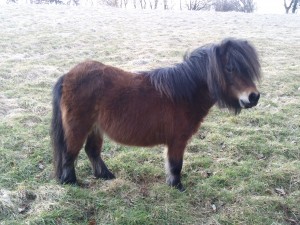The History Of Exmoor Ponies
 The Exmoor pony is one of the oldest breed of ponies native to the UK, that can still be found living wild in Exmoor. Often mixed up with Dartmoor ponies, the true Exmoor ponies have very specific colouring of a bay body, with a lighter muzzle, and a black mane and tale and legs.
The Exmoor pony is one of the oldest breed of ponies native to the UK, that can still be found living wild in Exmoor. Often mixed up with Dartmoor ponies, the true Exmoor ponies have very specific colouring of a bay body, with a lighter muzzle, and a black mane and tale and legs.
Today we have a guest author to tell us all some ofВ the history ofВ Exmoor ponies.
The Exmoor Pony
The Exmoor is the last survivor of the Celtic ponies from the Pleistocene age and one of the oldest equine breeds in the world. This ancient breed of pony is mentioned in the Domesday Book of 1085, Exmoors are believed to have existed during the Bronze Age.
Experiments have been conducted on the fossilised remains of the original Celtic pony found in Alaska and compared with those of the Exmoor. They have revealed the same shape jaw bones and the beginnings of a seventh molar tooth found in no other breed. Because of its remote habitat in Devon and Somerset it is one of the purist of the Mountain and Moorland breeds in Great Britain, having undergone very little infusion of outside blood.
Much research was carried out on the skeletal structures and dentition of the Exmoor pony by Professor Speed and others scientists. Their findings suggest that the modern domestic horse descended from the four sub type species:
The Exmoor Pony found in north-west Europe resembles Pony Type 1 – Ewart’s Celtic Pony. The Highland Pony – resembles Pony Type 2 – Ewart’s Norse Horse. Akhal-Teke – resembles Horse Type 3 – Nisaean and Bacterian breed. Caspian rediscovered in 1965 – resembles Horse Type 4 – forerunner of the Caspian that is a pony-sized horse of Western Asia.
The Exmoor pony is exceptionally strong and hardy with great powers of endurance. The height limit of the mare is no more than 12.2 h.h. and of the stallion 12.3 h.h. Although small in stature they are strong enough to carry an adult rider.
In 1912 The Exmoor Pony Society was founded to improve and encourage the breeding of moorland types. They ensure that the breed stays pure and only true Exmoor ponies are passed for registration and branded by the Society star on the shoulder. At the end of the Second World War the numbers of ponies fell to just 50, as thieves killed them for meat and soldiers used them for target practice. Today, though it is still considered a rare breed, the numbers are estimated at around 2,700 World-wide; the result of a successful breeding programme. Herds of Exmoor ponies still run wild on the moor, they are rounded up each year for inspection; the pony’s herd number is branded beneath the Society’s star and on the nearside hindquarter with the pony’s own number.
The Exmoor pony has true pony character and appeal. The mealy, buff coloured muzzle and markings around the eyes make the breed easy to recognise. The conformation is good and compact; the head is a typical pony head with a wide brow, short straight nose, large, prominent, intelligent eyes (often referred to as ‘toad’ eyes because of the heavy top lids) small, wide set, alert ears and wide nostrils; the head is well set on a strong neck with a good length of reign; the shoulders are sloping; the back is short, broad and strong; the body is deep with a broad chest and well sprung ribs; the hindquarters are round; the limbs are short and strong with well shaped hard feet; the mane and tail are thick, the tail known as an ‘ice’ tail, fans out at the top for protection from the weather. The winter coat is dense and double layered making it springy, virtually waterproof and an excellent protection against the wind and rain. Shedding its coat in spring The Exmoor grows a sleek and shiny summer coat. The colour may be bay, brown or mousy dun with black points and no white markings are permitted.
The Exmoor pony was originally used for herding on the moors as it is sure footed and has immense strength. It is robust and athletic with a strong constitution and can make a good all round performance pony with an ability to jump. It is often used in the sport of driving and though it is strong, with the correct handling and training it makes a very good child’s pony.
For more information on horses including pony breed associations go to http://www.horse-owners-world.co.uk the comprehensive equine site for all horse lovers. For horse art including portraits and commissions go to http://www.kathryndalziel.com.
Article Source: http://EzineArticles.com/?expert=Kathryn_Dalziel
http://EzineArticles.com/?The-Exmoor-Pony&id=2316032
Well, now we know more about the history of the Exmoor pony, and how this pony went from being a wild equine to a popular choice for a child’s riding pony.
 June 6, 2010
В·
June 6, 2010
В·  Maddia (Admin) В·
Maddia (Admin) В·  3 Comments
3 Comments
 Tags: equine, exmoor pony, history of exmoors, horse, horse and pony, Wild Ponies В· Posted in: Horse and Pony Breeds, Horse and Pony Information, Wild Ponies
Tags: equine, exmoor pony, history of exmoors, horse, horse and pony, Wild Ponies В· Posted in: Horse and Pony Breeds, Horse and Pony Information, Wild Ponies



3 Responses
Wow thanks, I had to research the history of exmoor ponies for a school science project :)
Where is Exmoor? Is it in Montana?
Exmoor is in South-West England.